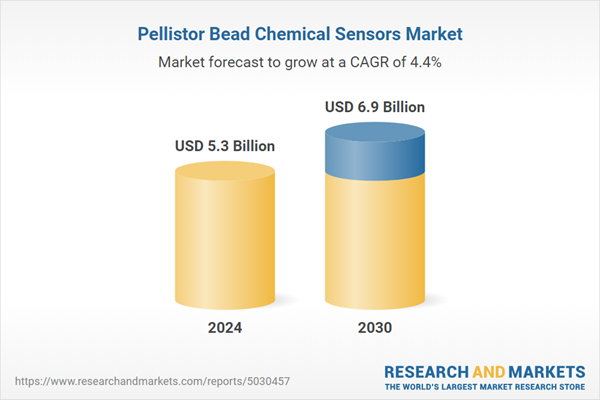Global Pellistor Bead Chemical Sensors Market - Key Trends & Drivers Summarized
How Are Technological Advancements Impacting Pellistor Bead Chemical Sensors?
Pellistor bead chemical sensors, widely used for detecting combustible gases, are benefiting from technological advancements that are enhancing their sensitivity, reliability, and versatility. Pellistor sensors, which function by measuring changes in heat produced during the combustion of gases, are increasingly being integrated with modern electronics to improve their detection capabilities. One of the key advancements is the miniaturization of sensors, enabling more compact and efficient designs suitable for portable and wearable gas detection devices. Additionally, advancements in materials science have improved the robustness and temperature stability of Pellistor sensors, allowing them to operate in harsh environments and detect a wider range of gases with greater accuracy. Modern calibration algorithms and AI-driven data analytics are also enhancing the accuracy of Pellistor sensors, reducing false positives and improving their applicability in industrial safety, environmental monitoring, and workplace compliance. These technological breakthroughs are making Pellistor bead chemical sensors more adaptable to the evolving demands of industries that rely on precise gas detection.Why Are Pellistor Bead Sensors Crucial in Industrial and Environmental Safety?
Pellistor bead chemical sensors are critical in ensuring safety in industrial and environmental settings where the detection of combustible gases is essential. These sensors are extensively used in industries such as oil and gas, mining, chemicals, and manufacturing, where the presence of explosive gases poses significant safety risks. Pellistor sensors are valued for their ability to detect gases like methane, propane, and hydrogen with high accuracy, alerting workers to potential hazards before they reach dangerous concentrations. Their robust design allows them to withstand challenging conditions, including high temperatures, pressure variations, and corrosive environments, making them ideal for deployment in hazardous locations. Additionally, the use of Pellistor sensors in environmental monitoring helps detect gas leaks and emissions, contributing to the prevention of air pollution and ensuring compliance with environmental regulations. As industries continue to prioritize safety and sustainability, the role of Pellistor bead sensors in gas detection and monitoring is becoming increasingly indispensable.How Are Market and Industry Trends Shaping the Demand for Pellistor Bead Chemical Sensors?
Shifting market and industry trends are influencing the growing demand for Pellistor bead chemical sensors, particularly as industries place greater emphasis on safety, compliance, and environmental responsibility. With stricter safety regulations and standards being implemented across sectors such as oil and gas, manufacturing, and energy, the need for reliable and accurate gas detection systems is more important than ever. Additionally, the rise in automation and the Industrial Internet of Things (IIoT) has led to increased integration of Pellistor sensors with advanced control systems, enabling real-time monitoring and immediate responses to gas leaks. Companies are also adopting more portable and wearable gas detection devices, further driving demand for compact Pellistor sensors that can be easily incorporated into handheld instruments and personal protective equipment (PPE). Furthermore, the growing focus on sustainability and reducing industrial emissions is pushing companies to invest in advanced gas detection technologies that can prevent accidental releases of harmful gases into the environment. As these trends continue to shape industry demands, Pellistor bead sensors are increasingly being adopted for their reliability, accuracy, and adaptability.What Factors Are Driving Growth in the Pellistor Bead Chemical Sensors Market?
The growth in the Pellistor bead chemical sensors market is driven by several factors related to industry needs, regulatory compliance, and technological advancements. One of the primary drivers is the rising emphasis on industrial safety, particularly in sectors where the detection of flammable gases is critical to preventing explosions and ensuring worker safety. The implementation of stricter environmental and workplace safety regulations globally is also pushing industries to adopt more reliable and accurate gas detection systems, boosting demand for Pellistor sensors. Technological advancements, including the miniaturization of sensors and the integration of digital and AI-driven monitoring systems, are making Pellistor sensors more versatile and applicable in various industries. Additionally, the growing trend toward wearable and portable gas detection devices, particularly in hazardous work environments, is fueling demand for compact and durable Pellistor bead sensors. The increasing adoption of Industrial Internet of Things (IIoT) solutions, which require continuous and precise monitoring of industrial processes, is further driving the market as companies seek more efficient ways to detect and manage gas leaks in real time. As safety, efficiency, and environmental responsibility become central to industrial operations, the Pellistor bead chemical sensors market is poised for sustained growth.Report Scope
The report analyzes the Pellistor Bead Chemical Sensors market, presented in terms of units. The analysis covers the key segments and geographic regions outlined below.Segments: End-Use (Industrial, Medical, Environmental, Defense, Other End-Uses).
Geographic Regions/Countries: World; United States; Canada; Japan; China; Europe (France; Germany; Italy; United Kingdom; Spain; Russia; and Rest of Europe); Asia-Pacific (Australia; India; South Korea; and Rest of Asia-Pacific); Latin America (Argentina; Brazil; Mexico; and Rest of Latin America); Middle East (Iran; Israel; Saudi Arabia; United Arab Emirates; and Rest of Middle East); and Africa.
Key Insights:
- Market Growth: Understand the significant growth trajectory of the Industrial segment, which is expected to reach US$1.7 Billion by 2030 with a CAGR of a 5.4%. The Medical segment is also set to grow at 3.3% CAGR over the analysis period.
- Regional Analysis: Gain insights into the U.S. market, valued at $1.4 Billion in 2024, and China, forecasted to grow at an impressive 7.9% CAGR to reach $1.6 Billion by 2030. Discover growth trends in other key regions, including Japan, Canada, Germany, and the Asia-Pacific.
Why You Should Buy This Report:
- Detailed Market Analysis: Access a thorough analysis of the Global Pellistor Bead Chemical Sensors Market, covering all major geographic regions and market segments.
- Competitive Insights: Get an overview of the competitive landscape, including the market presence of major players across different geographies.
- Future Trends and Drivers: Understand the key trends and drivers shaping the future of the Global Pellistor Bead Chemical Sensors Market.
- Actionable Insights: Benefit from actionable insights that can help you identify new revenue opportunities and make strategic business decisions.
Key Questions Answered:
- How is the Global Pellistor Bead Chemical Sensors Market expected to evolve by 2030?
- What are the main drivers and restraints affecting the market?
- Which market segments will grow the most over the forecast period?
- How will market shares for different regions and segments change by 2030?
- Who are the leading players in the market, and what are their prospects?
Report Features:
- Comprehensive Market Data: Independent analysis of annual sales and market forecasts in US$ Million from 2024 to 2030.
- In-Depth Regional Analysis: Detailed insights into key markets, including the U.S., China, Japan, Canada, Europe, Asia-Pacific, Latin America, Middle East, and Africa.
- Company Profiles: Coverage of players such as ABB Group, AirTest Technologies, Inc., Alpha MOS France, Digital Control Systems, Inc., Emerson Electric Co. and more.
- Complimentary Updates: Receive free report updates for one year to keep you informed of the latest market developments.
Some of the 17 companies featured in this Pellistor Bead Chemical Sensors market report include:
- ABB Group
- AirTest Technologies, Inc.
- Alpha MOS France
- Digital Control Systems, Inc.
- Emerson Electric Co.
- F. Hoffmann-La Roche AG
- General Electric Company
- Halma PLC
- Hans Turck GmbH & Co. KG
- Honeywell Analytics, Inc.
- Honeywell International, Inc.
- MSA Safety, Inc.
- Pepperl+Fuchs GmbH
- Robert Bosch GmbH
- Senseair AB
- SICK AG
- Siemens AG
- Smiths Detection, Inc.
- Teledyne Technologies, Inc.
Tariff Impact Analysis: Key Insights for 2025
Global tariff negotiations across 180+ countries are reshaping supply chains, costs, and competitiveness. This report reflects the latest developments as of April 2025 and incorporates forward-looking insights into the market outlook.The analysts continuously track trade developments worldwide, drawing insights from leading global economists and over 200 industry and policy institutions, including think tanks, trade organizations, and national economic advisory bodies. This intelligence is integrated into forecasting models to provide timely, data-driven analysis of emerging risks and opportunities.
What’s Included in This Edition:
- Tariff-adjusted market forecasts by region and segment
- Analysis of cost and supply chain implications by sourcing and trade exposure
- Strategic insights into geographic shifts
Buyers receive a free July 2025 update with:
- Finalized tariff impacts and new trade agreement effects
- Updated projections reflecting global sourcing and cost shifts
- Expanded country-specific coverage across the industry
Table of Contents
Companies Mentioned (Partial List)
A selection of companies mentioned in this report includes, but is not limited to:
- ABB Group
- AirTest Technologies, Inc.
- Alpha MOS France
- Digital Control Systems, Inc.
- Emerson Electric Co.
- F. Hoffmann-La Roche AG
- General Electric Company
- Halma PLC
- Hans Turck GmbH & Co. KG
- Honeywell Analytics, Inc.
- Honeywell International, Inc.
- MSA Safety, Inc.
- Pepperl+Fuchs GmbH
- Robert Bosch GmbH
- Senseair AB
- SICK AG
- Siemens AG
- Smiths Detection, Inc.
- Teledyne Technologies, Inc.
Table Information
| Report Attribute | Details |
|---|---|
| No. of Pages | 213 |
| Published | April 2025 |
| Forecast Period | 2024 - 2030 |
| Estimated Market Value ( USD | $ 5.3 Billion |
| Forecasted Market Value ( USD | $ 6.9 Billion |
| Compound Annual Growth Rate | 4.4% |
| Regions Covered | Global |









